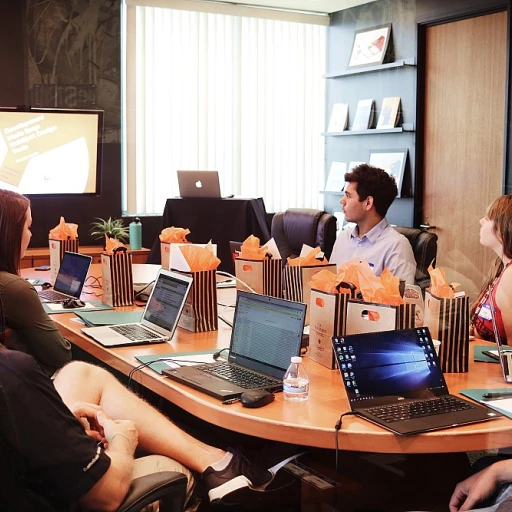
Understanding the Importance of Feedback in HR Leadership
The Significance of Feedback in HR Leadership
In the dynamic landscape of human resources, feedback has evolved into a cornerstone of effective leadership. As a Chief Human Resources Officer (CHRO), mastering the art of giving and receiving feedback is integral to your success and, ultimately, the success of your organization. A well-structured feedback system encourages a culture of open communication, essential for nurturing growth and development within teams.
The essence of feedback lies in its dual nature—giving and receiving. On one hand, giving feedback constructively enhances team performance by highlighting areas for improvement and recognizing achievements. On the other hand, receiving feedback helps leaders like CHROs to refine their own skills and understand the impact of their decisions on the team.
Effective communication is a pivotal skill that facilitates productive feedback exchanges. This skill helps in ensuring that the message is both clear and motivating, empowering team members to embrace feedback activities positively. Communication skills can be enhanced through feedback training exercises, which prepare leaders to handle feedback scenarios with confidence and empathy.
As a CHRO, you are in a unique position to cultivate a feedback culture within the organization. Encouraging transparency and radical candor, where feedback is given constructively and openly, can lead to transformative improvements within the team's dynamics. Over time, this practice garners trust and fosters a more cohesive and motivated team atmosphere.
Acknowledging the significance of feedback in HR leadership is an initial step. To further enhance your capabilities, explore ways to stay motivated and engaged in your role through continuous learning and adaptation. For insights on maintaining engagement in your HR leadership role, read more about motivation and engagement strategies for CHROs.
Key Skills for Effective Feedback Delivery
Developing Core Competencies for Feedback Excellence
To excel as a Chief Human Resources Officer, possessing key skills in the realm of feedback is essential. These competencies not only enhance communication within the team but also foster an environment where constructive criticism leads to growth and improvement. Let's delve into some pivotal skills that are necessary for effective feedback delivery.- Active Listening
Active listening is the bedrock of any successful feedback session. It ensures that the person receiving feedback feels heard and understood. As a CHRO, it is crucial to practice attentive listening, making team members feel valued and respected. - Clarity and Precision
Delivering feedback involves clarity in communication. It's important to articulate observations with precision, ensuring that the feedback is specific and actionable. This practice helps in delivering feedback that is constructive and focuses on areas of improvement. - Emotional Intelligence
A cornerstone of effective feedback is managing emotions—your own and those of the person receiving feedback. Understanding and empathizing with their perspective helps tailor your approach, fostering a more positive experience. - Constructive Feedback Techniques
Employing techniques like "radical candor" allows for the delivery of feedback that is direct, yet empathetic. This form of delivery encourages open dialogues and continuous growth for all team members involved. - Timing and Context
The timing and context of your feedback can significantly impact its effectiveness. Choose an appropriate time, ensuring the person is open to receiving feedback, thus maximizing the chances for a constructive outcome. - Consistent Feedback Culture
To thrive, teams require a culture where feedback is a regular and natural part of the workflow. Implementing feedback activities and exercises regularly can embed this culture into the organization. - Feedback Practice and Training
Engaging in continuous training and feedback exercises can refine your skills. Participating in group activities or working with feedback training professionals will help fine-tune these competencies over time.
Creating a Feedback-Friendly Environment
Fostering a Culture of Open Communication
Creating an environment where feedback flows freely is crucial for any Chief Human Resources Officer (CHRO). One way to cultivate this is by establishing a culture that emphasizes transparent, open communication. When team members feel that their voices will be heard and valued, they become more inclined to engage constructively. The key is to encourage both giving and receiving of feedback. This can be done through regular feedback exercises that involve all team members, ensuring everyone gets the opportunity to participate. By making feedback a routine activity, you reinforce its importance and help people become more comfortable with the process—it becomes less intimidating over time.Building Trust With Your Team
Trust is foundational when it comes to creating a feedback-friendly atmosphere. Team members need to believe that their feedback will be received positively and lead to constructive outcomes. Effective communication skills are vital for fostering this trust. It’s helpful to demonstrate radical candor, where you openly and respectfully share feedback. This creates a safe space for others to do the same. By being consistent in your approach and showing understanding when receiving feedback, you set a standard for the group.Facilitating Feedback Training Sessions
Consider organizing feedback training sessions, especially designed to equip your people with the necessary skills for constructive feedback exchanges. These sessions can include feedback activities and exercises that last only a few minutes but have a long-lasting impact on communication skills. Training materials should focus on practical aspects of feedback, such as the following:- How to practice giving feedback in a way that encourages areas of improvement.
- Effective ways to process feedback received, enabling participants to act on it.
Incorporating Regular Feedback Channels
Lastly, it's critical to implement consistent feedback channels within the organization. Whether through regular one-on-one meetings, group feedback sessions, or anonymous surveys, having diverse means for feedback can accommodate different comfort levels among team members. Building such channels requires time and commitment, but they significantly contribute to a rich feedback culture. Encourage everyone to participate; when practice giving and receiving feedback becomes habitual, it leads to positive outcomes and strengthens team cohesion. For more insights on enhancing feedback practices within your team, explore this resource on just-in-time training for HR leaders, which offers actionable strategies to support HR professionals in their journey towards improved feedback systems.Techniques for Receiving Feedback as a CHRO
Embracing Feedback as an Opportunity for Growth
For Chief Human Resources Officers (CHROs), creating a culture of effective feedback is only half the battle. Being adept at receiving feedback with an open mind is equally crucial. Often, leaders can find it challenging to be receptive to opinions or insights about their own performance. However, this exchange is vital for fostering a transparent and positive communication environment.
The first step in this process is to encourage a mindset where feedback is perceived as a cornerstone for professional and personal growth. A skilled CHRO understands that feedback, whether positive or constructive, provides areas for improvement and helps in refining the organization’s human resources strategies.
Fostering a Listening Culture
Creating an atmosphere where every team member feels comfortable expressing their thoughts contributes significantly to a feedback-friendly environment. Engage in feedback exercises that involve group activities and exercises designed to develop and practice listening skills. This could be as simple as dedicating a few minutes materials in quarterly meetings for radical candor sessions where team members are encouraged to share their thoughts freely.
When leaders actively listen, they exhibit effective communication skills, showcasing the willingness to receive new insights and adjust work styles as needed. This fosters an environment where team members are more likely to follow suit, thus promoting a holistic culture of open communication and continuous learning.
Responding to Feedback
Effective feedback is not a one-way street. Once feedback is received, how CHROs respond plays a critical role in maintaining the flow of communication. Acknowledge the feedback received promptly and clarify any doubts by asking questions respectfully. Demonstrating genuine appreciation for the given feedback enhances trust and encourages others to continue to provide useful insights.
Incorporate a strategy to analyze the received feedback and, where appropriate, implement changes based on it. This not only addresses the team’s suggestions but also aligns the leadership with the company’s evolving dynamics, leading to an overall improvement in team performance.
Continuous Training and Development
Consider investing in feedback training for the CHROs and their team. Engaging in activities that enhance feedback skills helps hone the art of giving and receiving feedback effectively. Training programs can include interactive feedback activities tailored to HR leadership roles. These can range from peer-review systems to hands-on feedback exercises that invite participants to play roles in providing constructive feedback.
Ultimately, receiving feedback as a CHRO is about collecting actionable insights that contribute to both personal development and organizational excellence. It's a continuous process that requires patience, will, and the dedicated exercise of advanced communication skills. By embracing this journey, CHROs not only enhance their own leadership capabilities but also uplift the entire organization.
Overcoming Common Feedback Challenges
Mastering Feedback-Related Challenges
Chief Human Resources Officers (CHROs) often encounter a range of common feedback challenges that can impede effective communication and hamper the development of a constructive feedback culture within their organizations. Addressing these challenges with a strategic approach can significantly improve the feedback processes and outcomes for any team.
One prevalent challenge is overcoming resistance to feedback. Team members may perceive feedback negatively, often associating it with criticism rather than an opportunity for growth. To counteract this, CHROs will need to work on reframing feedback as a tool for development. Promoting a culture of 'radical candor'—where expressing care and challenging directly go hand in hand—can help build trust and openness among participants.
Another challenge is ensuring the right balance between giving and receiving feedback. Effective feedback involves not only delivering input but also creating an environment where team members feel comfortable sharing their perspectives. This involves honing both the communication skills of the person giving feedback and their ability to actively listen when receiving feedback.
Time constraints often pose a barrier for feedback exercises and activities. To address this, feedback sessions can be incorporated into regular team meetings by allocating just a few minutes. This practice turns feedback into a regular activity rather than a sporadic event, ultimately embedding it into the team’s work routine without significant disruption.
Finally, a lack of feedback training can lead to ineffective feedback delivery. Incorporating feedback training into professional development initiatives can enhance the skills of team members in both giving and receiving constructive feedback. Regular feedback activities and skills-building exercises support participants in mastering this essential component of their roles.
Implementing Feedback Systems in Organizations
Building a Robust Feedback System
Implementing a feedback system in an organization is not just about setting up processes; it’s about creating a culture where feedback is a natural and welcomed part of everyday work life. A well-structured feedback system can significantly enhance communication skills among team members, promote areas of improvement, and foster a positive work environment.
Designing Feedback Activities
To ensure the feedback system is effective, it’s crucial to incorporate regular feedback activities. These activities can include structured feedback exercises where team members practice giving and receiving feedback in a controlled setting. Such exercises can be as simple as dedicating a few minutes in team meetings for feedback sessions or organizing workshops where participants engage in role-playing to simulate real-life scenarios.
Training and Development
Feedback training is essential for both giving and receiving feedback effectively. Training sessions should focus on developing communication skills, understanding the principles of radical candor, and learning how to deliver constructive feedback. This training can help team members feel more comfortable and confident when engaging in feedback activities, ultimately leading to more effective feedback exchanges.
Monitoring and Evaluation
Once a feedback system is in place, it’s important to regularly evaluate its effectiveness. This can be done by collecting feedback on the feedback process itself. Encourage team members to share their experiences and suggestions for improvement. This ongoing evaluation will help refine the system, ensuring it remains relevant and effective over time.
Encouraging a Feedback Culture
Creating a feedback-friendly environment requires commitment from all levels of the organization. Leaders should model the behavior they wish to see by actively participating in feedback activities and demonstrating openness to receiving feedback. By doing so, they set a precedent for team members, encouraging them to engage in feedback exercises and view feedback as a tool for personal and professional growth.













